
A flatfish is a member of the ray-finned demersal fish order Pleuronectiformes, also called the Heterosomata, sometimes classified as a suborder of Perciformes. In many species, both eyes lie on one side of the head, one or the other migrating through or around the head during development. Some species face their left sides upward, some face their right sides upward, and others face either side upward.
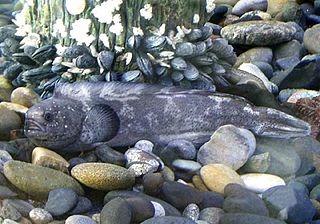
The prowfish is a species of scorpaeniform marine fish found in the northern Pacific Ocean. It is the only extant member of the family, Zaproridae. Another species, Araeosteus rothi, is known from Late Miocene marine strata in Southern California.

Fish locomotion is the various types of animal locomotion used by fish, principally by swimming. This is achieved in different groups of fish by a variety of mechanisms of propulsion, most often by wave-like lateral flexions of the fish's body and tail in the water, and in various specialised fish by motions of the fins. The major forms of locomotion in fish are:

The Zeidae are a family of large, showy, deep-bodied zeiform marine fish—the "true dories". Found in the Atlantic, Indian, and Pacific Oceans, the family contains just six species in two genera. All species are important and highly regarded food fish supporting commercial fisheries, and some—such as the John Dory —are enjoyed in large public aquaria. These fish are caught primarily by deep-sea trawling.

Pleuronectidae, also known as righteye flounders, are a family of flounders. They are called "righteye flounders" because most species lie on the sea bottom on their left sides, with both eyes on their right sides. The Paralichthyidae are the opposite, with their eyes on the left side. A small number of species in Pleuronectidae can also have their eyes on the left side, notably the members of the genus Platichthys.

White sturgeon is a species of sturgeon in the family Acipenseridae of the order Acipenseriformes. They are an anadromous (migratory) fish species ranging in the Eastern Pacific; from the Gulf of Alaska to Monterey, California. However, some are landlocked in the Columbia River Drainage, Montana, and Lake Shasta in California, with reported sightings in northern Baja California, Mexico.

The Pacific staghorn sculpin is a species of marine ray-finned fish belonging to the family Cottidae, the typical sculpins. This species is found in the eastern Pacific Ocean. It is the only species in the monospecific genus Lepidocottus.
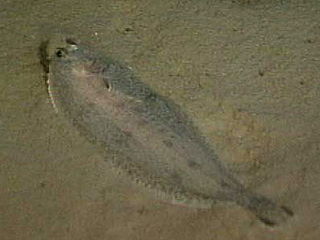
The witch, known in English by a variety of other common names including the witch flounder, pole flounder, craig fluke, Torbay sole, and grey sole, is a species of flatfish from the family Pleuronectidae. It occurs on both sides of the North Atlantic Ocean on muddy sea beds in quite deep water. In northern Europe it has some importance in fisheries as a food fish.
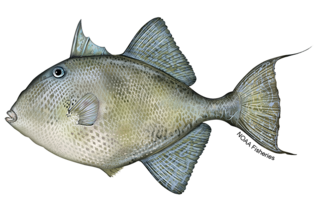
The grey triggerfish, or gray triggerfish, is a species of ray-finned fish in the triggerfish family. The species is native to shallow parts of the western Atlantic from Nova Scotia to Argentina and also the eastern Atlantic, the Mediterranean Sea and off Angola on the west coast of Africa.

Paralabrax clathratus, the kelp bass, bull bass or calico bass, is a species of marine ray-finned fish, a sea bass from the subfamily Serraninae, classified as part of the family Serranidae which includes the groupers and anthias. It is found in the eastern North Pacific Ocean where it is an important species for both recreational and commercial fisheries.

The European flounder is a flatfish of European coastal waters from the White Sea in the north to the Mediterranean and the Black Sea in the south. It has been introduced into the United States and Canada accidentally through transport in ballast water. It is caught and used for human consumption.

Arothron stellatus, also known as the stellate puffer, starry puffer, starry pufferfish, or starry toadfish, is a demersal marine fish belonging to the family Tetraodontidae. It is found in shallow water in the Indo-Pacific region.

The Pacific sand sole, also known as simply sand sole, is a flatfish species inhabiting the northeastern Pacific waters where it lives on sandy bottoms. The only species in the genus, Psettichthys, it ranges from the Bering Sea to Northern California.

The flathead sole is a flatfish of the family Pleuronectidae. It is a demersal fish that lives on soft, silty or muddy bottoms at depths of up to 1,050 metres (3,440 ft). Its native habitat is the northern Pacific, from the seas of Japan and Okhotsk, across the Bering Sea and to the coast of North America, as far south as Point Reyes, United States. It grows to 52 centimetres (20 in) in length, and can weigh up to 1.56 kilograms (3.4 lb); females are typically larger than males. Lifespan is at least 27 years for females and at least 30 years for males.

The starry rockfish, also known as the spotted corsair, spotted rockfish, chinafish, and red rock cod, is a species of marine ray-finned fish belonging to the subfamily Sebastinae, the rockfishes, part of the family Scorpaenidae. It is found in the eastern Pacific Ocean.
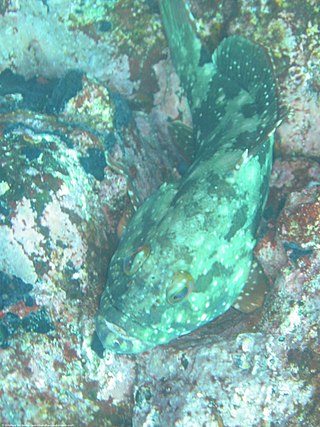
Epinephelus labriformis, commonly called starry grouper or flag cabrilla is a species of marine ray-finned fish, a grouper from the subfamily Epinephelinae which is part of the family Serranidae, which also includes the anthias and sea basses. It is found in the eastern Pacific Ocean.
Ammodytes americanus, also known as American sand lance, American sand eel, and sand launce, is a small fish in the family Ammodytidae. First described by James Ellsworth De Kay in 1842, it is widespread in the western North Atlantic. Like all sand lances, it has a long, thin body with a pointed snout; mature fish typically range from 4 to 6 in in length, though some may reach 7 in (18 cm). Its back is greenish-brown, while its sides and abdomen are silvery. It has a long, low dorsal fin which extends along most of its back, folding into a groove at the fin's base when not in use. Its anal fin is roughly the same height as the dorsal fin, and extends over the posterior third of the fish's body. Its pectoral fins are small, and its caudal fin is forked. Its mouth is large and toothless, with a lower jaw that extends well beyond the upper. It typically travels in large schools, spending most of its time relatively near the water surface. It feeds primarily on plankton, though it is known to take small clams and snails from the sea floor, presumably when plankton is scarce. Towards dusk, schools of A. americanus bury themselves in sand, typically from 1 to 6 in below the sand's surface close to the water's edge; they avoid rocky areas. They do this to avoid being detected by night-hunting species such as bluefish and stripers.

Sebastes elongatus, the greenstriped rockfish, striped rockfish, strawberry rockfish, poinsettas, reina or serena, is a species of marine ray-finned fish belonging to the subfamily Sebastinae, the rockfishes, part of the family Scorpaenidae. It is found in the northeastern Pacific Ocean.

Sebastes reedi the yellowmouth rockfish, is a species of marine ray-finned fish belonging to the subfamily Sebastinae, the rockfishes, part of the family Scorpaenidae. It is found in the Eastern Pacific.
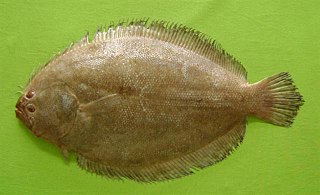
Pseudorhombus arsius, the largetooth flounder, is a species of left-eyed flatfish, that is the dark side with the eyes on the adult fish is the left side of the fish's body, from the family Paralichthyidae. As Rhombus polyspilos it was named as the type species of the genus Pseudorhombus. It is an Indo-Pacific species and is fished for by both recreational and commercial fisheries.





















